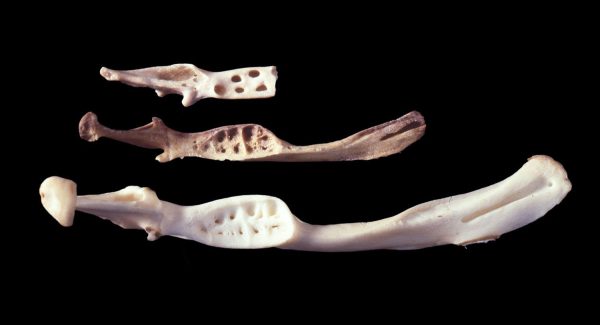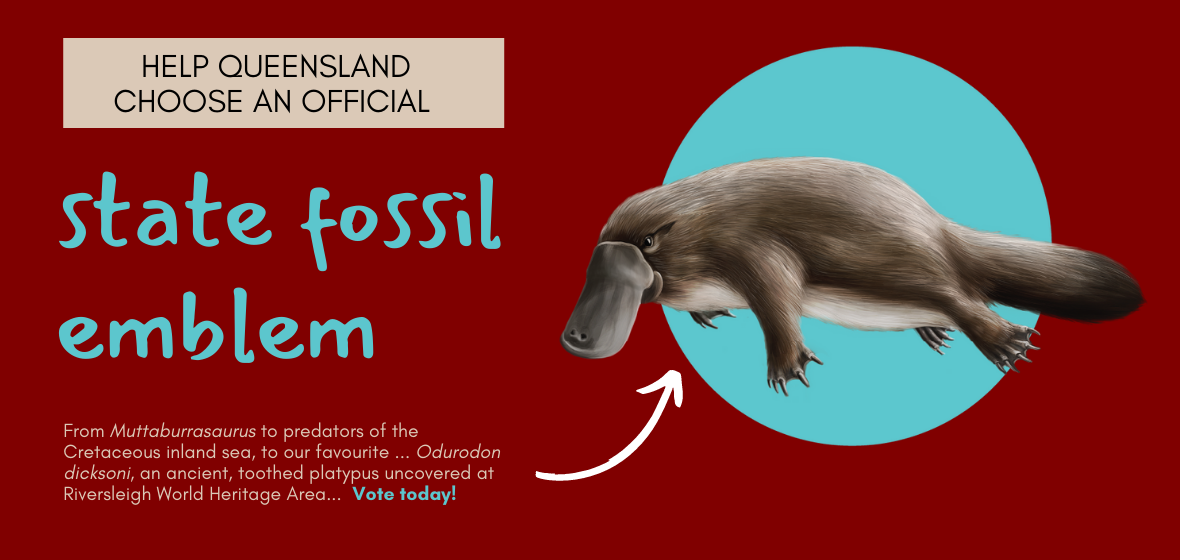11 April
Tourism Minister Stirling Hinchliffe has announced that Queenslanders will be able to pick their favourite fossil to add to Queensland’s nine official emblems from April 11 – and one of them is an ancient platypus.
After feedback from museums, tourism organisations and councils, 12 fossils have been shortlisted by the Palaszczuk Government.
‘Each of the dozen fossils on the shortlist symbolises Queensland’s natural history, unique landscape and biodiversity,’ Mr Hinchliffe said. ‘Many of the southern hemisphere’s best dinosaur finds are in Outback Queensland. We know Australian and overseas visitors are enthralled by Queensland’s rich palaeontological history. Thousands of visitors flock to Queensland’s Outback every year to discover the State’s prehistoric dinosaur remains, generating millions of dollars for our tourism economy.
‘Queenslanders have previously chosen nine State emblems including the koala, Cooktown orchid, the brolga, sapphire gem, Great Barrier Reef Anemone fish, and an official colour – the mighty maroon.
‘From land-based dinosaurs and sea predators to crocodiles and ancient fauna and flora, we’re now asking Queenslanders to have their say on the fossil that best represents the State’s prehistoric age.’
The Palaszczuk Government has consulted with regional tourism organisations, councils and museum palaeontology experts to shortlist a dozen fossils for Queensland’s tenth official emblem:
Diamantinasaurus matildae – Heavily-built titanosaur
Kronosaurus queenslandicus – Super-predator of the Cretaceous seas
Muttaburrasaurus langdoni – Big-nosed ornithopod
Isisfordia duncani – Oldest known crocodile
Eromangasaurus australis – Long-necked elasmosaur
Rhoetosaurus brownie – Jurassic-aged sauropod
Australotitan Cooperensis – Large titanosaur
Richmond polycotylid – Long-snouted plesiosaur
Obdurodon dicksoni – Ancient platypus with teeth
Lovellea wintonensis – oldest known permineralised fossil flower
Siderops kehli – Giant Jurassic amphibian
Ridersia watsonae – Early Sea lily-like animal

Obdurodon dicksoni is known from a fossilised jaw bone found at Riversleigh World Heritage Area in northwestern Queensland. Photo: Queensland Museum
Queensland Museum CEO Dr Jim Thompson said Queensland Museum Network scientists had been involved in the rich and ongoing fossil story.
‘At Queensland Museum Network, we take our role as custodians of the State Collection, including our fossil treasures, very seriously. Our team of palaeontologists work with regional museums around the state to share their knowledge and ensure the stories of our fossil history is shared far and wide,’ Dr Thompson said.
‘Australia is one of the last frontiers for dinosaur discovery and Queensland is rapidly becoming known as the paleo-capital of the nation – so it is a must that we have a fossil emblem that represents our state.’
Queensland Museum Principal Curator Geosciences Dr Andrew Rozefelds said surprising new fossil finds are being uncovered each year.
“We see evidence of massive climate change, volcanic eruptions, extinction events and faunas and floras that are now long gone,” Dr Rozefelds said.
‘The fossil record can also tell us about the antecedents, the ancestors that gave rise to our modern Australian flora and fauna. This incredible wealth of discoveries from Queensland provides very rich pickings to select a state fossil emblem for Queensland.’
Help an ancient platypus rise to the top!
Of course, here at Wildlife Queensland, we’re excited to see Obdurodon dicksoni on the list, and we know it will get our vote. Known as the Riversleigh Platypus, this large ancient monotreme lived 13.5–18.2 million years ago and is known only from a skull, lower jaw and teeth – the latter of which modern platypuses lack entirely as adults. Although considered a precursor, O. dicksoni may not be a direct ancestor of the extant platypus (Ornithorhynchus anatinus), the star of Wildlife Queensland’s PlatypusWatch Network, as several fossils of Obdurodon species have now been found. It seems likely that the smaller Obdurodon insigna gave rise to today’s modern, toothless monotreme.
The state fossil emblem public consultation period will run from 11 April 2022 to 10 July 2022.
To learn more about each of the nominees and to have your say visit www.qld.gov.au/fossilemblem
To help today’s living platypus, join our PlatypusWatch Network and sign up for our FREE enews bulletin to be kept in the loop about citizen science events and news relating to this fascinating species.

